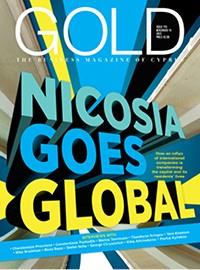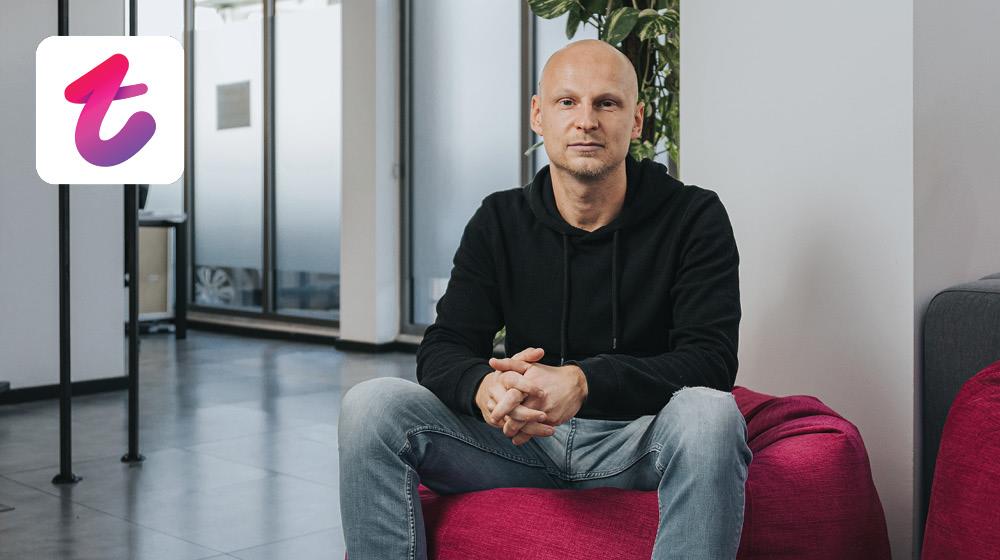In summer 2022, live-streaming platform Tango moved a team of 60 coders to Cyprus due to the war in Ukraine. Here, Alexander Eshchenko, Cyprus Site manager and Director of Product, discusses the rise, fall and re-rise of the company and the reasons behind the explosive popularity of live streaming.
“It is neither television nor social media – live streaming is a completely new thing,” Alexander Eshchenko says, and not for the first time, as social live streaming mainly exists within the purview of the younger generation. We are sitting on a black leather sofa on the second floor of Tango’s Limassol office, our reflections mirrored in the large TV screen across the coffee table. The best way to describe Tango (an interpretation that Eshchenko shares) is that it is a bar in digital form. In this particular establishment, you will mostly find women but there are also friends hanging out as well as the occasional artist trying to make a buck.
Live streaming is Tango’s second wind. In 2009, entrepreneurs Uri Raz and Eric Setton co-founded the startup in the sunny hills of Mountain View, California, the home of some of the world’s biggest tech companies, to compete with Skype and FaceTime in the then emerging free video call and messaging space. In the first nine months of its operation, Tango outpaced Skype’s first year by a margin of eight million registered users. It naturally attracted significant capital to expand into other markets, including Russia. At the time, Eshchenko was a QA Engineer at Yandex, known as the ‘Google of Russia’. For someone who had lived, studied and worked all his life in and around cold St. Petersburg, working for a US company and spending time in California was too good an opportunity to pass. “It was the next step in my career,” he says. Only a year after he joined, the Alibaba Holding Group’s massive US$251 million bet sent Tango into the orbit of unicorns. Alas, the market proved unforgiving and WhatsApp swallowed the whole world, becoming the main mode of online communication for Europe, Africa, the Indian subcontinent and Latin America. Inevitably, investor pressure drove Tango’s founders to make some hard choices, including downsizing from some 400 people to a core of 30-40 engineers (Eshchenko made the cut) who were tasked with the mission to pivot the startup into a space that had already taken Asia by storm. Live streaming had emerged in China as early as 2005 when public chatroom companies like YY were refurbished to hold live performances. Driven by Chinese millennials, it grew into a US$5 billion industry in just ten years. Although Western markets were a bit slower on the uptake – Tango was one of the first to enter the space – in 2019, the US alone counted 126 million viewers, a number that doubled the following year. Interestingly, the success didn’t come from Western markets. It managed to reach profitability, growing at an average of 2.5x YoY in core business metrics and headcount, opening three offices in Minsk, Kyiv and St. Petersburg. In a 2022 report produced by app analytics company Data.ai, which scoured 100 million data points across 250,000 apps, Tango led the way in terms of consumer spending in Turkey, Egypt and India and was in the top five in Saudi Arabia and Colombia. Its forced relocation, which saw the offices move to Warsaw, Dubai and Limassol, brought about another contraction, albeit a smaller one this time; from slightly over 400 employees, it dropped to 300.
“We were also less innovative since all the management’s attention was on completing the relocation process,” Eshchenko explains. The Limassol site was the first to do so, and by September 2022, it had started to deliver strategic projects and was looking at hiring more people.
In jeans and a black hoodie, Eshchenko, who has been a welcoming host, appears indistinguishable from the rest of his staff, some of whom are gathered around on colourful poufs on the ground floor for a meeting. There are 65 people in the Limassol site, most of whom are coders. Eshchenko is the Site Manager and Director of Product, which essentially makes the office the centre of a company that is all about the product. Apart from five of them, the rest – what used to be the St. Petersburg team – arrived after the invasion of Ukraine. Eshchenko’s priority is for his coders to focus all their attention on being creative, which explains the site’s setup. The entire second floor is divided into two main areas: via a narrow, twisting wrought-iron staircase you enter a lunchroom lined with rows of tables (and chafing dishes on the side), walk straight through a small passage, and exit into what can best be described as a ‘decompression room’, which is where Alexander Eshchenko and I now find ourselves.
While the company’s move to Cyprus made sense on paper – it had already gone through the rigmarole of company registration and favourable tax incentives sweetened the deal – Tango was not the only one that had the idea to move here. According to data released by the Ministry of Interior, up to August 2022, some 4,524 families had applied to relocate to Cyprus as part of the government’s headquartering initiative spearheaded by the country’s investment promotion agency Invest Cyprus, which had recently turned its attention towards tech companies. At the same time, since the outbreak of the war in Ukraine, some 20,000 Ukrainians, Russians and Belarusians had moved to Cyprus. The sudden population burst had at least two consequences: first, residential rents skyrocketed while purchase options fell in Limassol and Nicosia, the two main destinations of the incoming professionals. As a result, a big chunk of Tango’s employees has moved to the outskirts of Limassol, while others commute daily from Larnaca and Paphos. The second consequence was that neither the public nor the private secondary school systems were prepared (and how could they have been?) to absorb the swell of foreign students. “I personally believe that this is the biggest current challenge,” Eshchenko tells me, “because we usually hire engineers who have kids. Creating a good environment and providing a good education for their children is their number one priority; they want to protect their kids, so they won’t be in the same situation that we faced. So, the question is, who will be faster? Every year, engineers take decisions based on the environment and if they can provide better schooling for their kids in Dubai, for example, there is a high probability that they will move there, and we will not have any other tools to retain them,” he says, visibly concerned about such a likelihood.
By the end of 2022, live streaming reached some 30% of the world’s digital population, largely driven by the economic headwinds created by the pandemic. Eshchenko explains how, during the lockdowns, it added a specific section for artists due to rising interest from performers, since live streaming was a cost-effective way to cover some of their losses. Unlike television, radio or other traditional media, there are no fees attached to live streaming and the only operational expense involves a phone or a laptop – maybe throw in a set of cheap lights for good measure. On the other hand, platforms made it fairly easy for streamers to monetise their content. For Tango, this is also its main revenue stream. Much like a bank, it issues coins that users can buy – prices range between €1.14 for 100 coins to €56.99 for 5,000 coins – and convert them to various gifts that they send to streamers, who can then redeem them in a real-world currency.
“Why would someone send money to a streamer, if they are not an artist? What does the viewer get out of it?” I ask him.
“I’ll show you,” he says.
He pulls up his phone and goes on the app. On the screen, an attractive 20-something-year-old girl is doing nothing of note. He runs his finger across the screen, and a digital bouquet of flowers travels into one of the boxes next to her face.
“Aww! Thank you, Alex!” she says with glee.
He locks his phone and turns to me. “We call this the emotional touch, and this is what people are looking for,” he explains.
During the lonely pandemic lockdowns, people went on the platform to have a conversation with someone, often a beautiful woman living thousands of miles away, and every day, they would come back to the same steamer, forming a relationship that continued after the world rediscovered some semblance of normality. They had become, essentially, patrons of this digital bar, where sending digital gifts was akin to buying a drink (without the fear of rejection, one might add).
In 2022, north of US$100 million circulated on Tango’s platform from 10 million monthly active users. The most successful streamer banked US$1 million. As one of the first to get on the platform, she had time to learn how the game was played. Rule number one: the more time you spend on the platform, the more attention you will receive, and the more you will earn – it is all about playing the odds. She is, though, the exception. For most, live streaming is a side hustle but Eshchenko points out that, considering the countries Tango excels, making US$100 extra a month is a big deal. “This is why the platform is so successful: we have a very long tail of very simple creators,” he says. Incidentally, Eshchenko informs me that Tango is number one in India because of government-imposed embargoes on Chinese products, which removed the dominant force of TikTok from the market. On top of that, Tango has yet to spend any money on marketing. “Our success came organically because the product is good. And this is why we didn’t have such big expenses, compared to our main competitors, which allowed us to be very profitable. We are in the top three right now,” he says. Recently, together with some of the Limassol site’s leaders, he visited India to see how the company can expand its presence and discovered that, unlike the West where credit cards are the main payment mode, Indian users prefer digital wallets. Eshchenko is confident that integrating these payment methods on the platform could lead up to a 10-times increase in the size of the market in which Tango operates.
It would be fair to say that, at its first attempt it lost the fight but still managed to go the distance, while this time, Tango made the right bet. In this strange and amorphous digital economy, live streaming has already become a viable business model for tech companies and people alike. And with the younger generation using it as if it is second nature, one can only wonder how many more people will be going live in 10 years’ time.
This interview first appeared in the March issue of GOLD magazine. Click here to view it.









